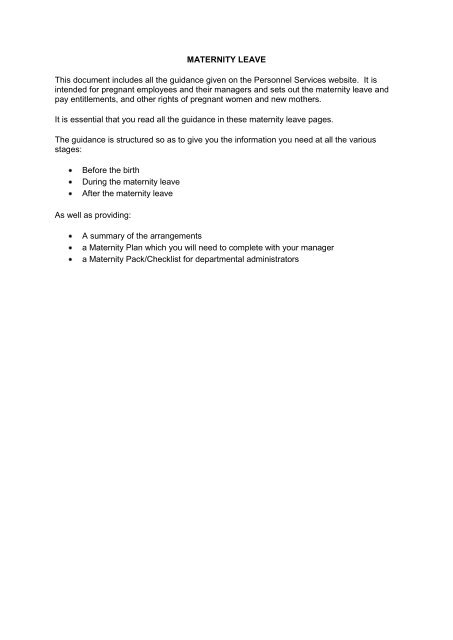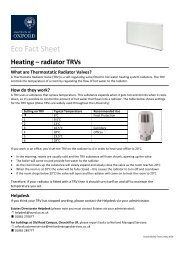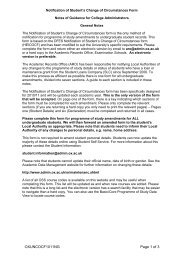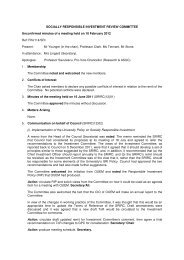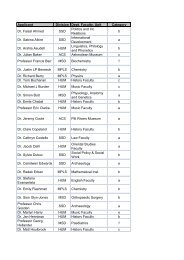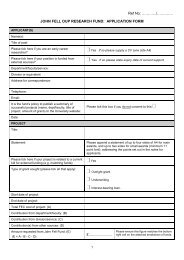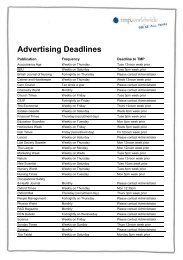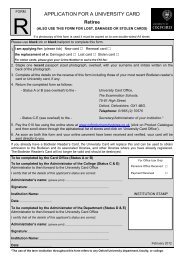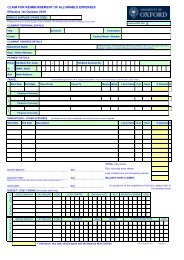Maternity leave - University of Oxford
Maternity leave - University of Oxford
Maternity leave - University of Oxford
You also want an ePaper? Increase the reach of your titles
YUMPU automatically turns print PDFs into web optimized ePapers that Google loves.
A <strong>Maternity</strong> Leave Plan is provided for employees and departments to use to collect thisinformation and other details relating to the proposed maternity <strong>leave</strong> period. If the <strong>Maternity</strong>Leave Plan is completed fully by the employee and the department this will ensure that thenotification requirements are met.The employee should also provide her department with a copy <strong>of</strong> her MATB1 form that shewill have been given by her healthcare provider (usually the GP or midwife) sometimearound the 25th week <strong>of</strong> pregnancy.When <strong>leave</strong> can beginA woman may choose to start her maternity <strong>leave</strong> any time after the beginning <strong>of</strong> the 11thweek before the expected week <strong>of</strong> childbirth. <strong>Maternity</strong> <strong>leave</strong> will start automatically if shegives birth before her notified date, or if she is ill for a pregnancy-related reason during thelast four weeks <strong>of</strong> her pregnancy.If an employee does not give her department the required notification for the start <strong>of</strong> hermaternity <strong>leave</strong>, she may lose her right to start maternity <strong>leave</strong> on her chosen date.Departments are only required to make exceptions to this where it was not reasonablypracticable for the notice to have been given any earlier.If the department and employee fill in the <strong>Maternity</strong> Leave Plan then this will satisfy thenotification requirements in this respect.Changing the start <strong>of</strong> maternity <strong>leave</strong>Once a woman has notified her department <strong>of</strong> the date she wishes to start her maternity<strong>leave</strong>, she can change this date as long as she notifies her department <strong>of</strong> the new start dateby whichever is the earlier <strong>of</strong> either 28 days before the date she originally intended to starther <strong>leave</strong> or 28 days before the new date she wants to start her <strong>leave</strong>.If it is not reasonably practicable for her to give this much notice (for example if the baby isborn early and she has to start her <strong>leave</strong> straight away) then she should tell her departmentas soon as she can. The notification does not have to be in writing unless the departmentrequests it.Confirmation by the department <strong>of</strong> the end date <strong>of</strong> <strong>leave</strong>Once an employee has provided the necessary notice <strong>of</strong> the intended start date <strong>of</strong> her <strong>leave</strong>,her department should in turn notify the employee <strong>of</strong> the date on which the <strong>leave</strong> will end.This will normally be 52 weeks (one year) from the start <strong>of</strong> maternity <strong>leave</strong>, except where anemployee has already stated her intention to take only a portion <strong>of</strong> the 52 week entitlement.There is a <strong>Maternity</strong> Leave Plan and letter which can be used for this purpose.The department should normally confirm the end date <strong>of</strong> the employee's maternity <strong>leave</strong> withher within 28 days <strong>of</strong> the notification.The start <strong>of</strong> maternity <strong>leave</strong>The maternity <strong>leave</strong> period normally starts on the date the employee has notified to herdepartment that she intends to start <strong>leave</strong>. There are some exceptions to this rule as follows:(i) Absence due to childbirth before the intended start date
If the baby is born before the date the employee has notified that she wishes to start <strong>leave</strong>(or before she has had the opportunity to notify any date) the maternity <strong>leave</strong> period startsautomatically on the day after the date <strong>of</strong> the birth. This happens even if the birth takes placebefore the 11th week before the birth was originally expected. In this circumstance thewoman should give her department notice (in writing if the department asks for it) <strong>of</strong> the date<strong>of</strong> the birth if it has already taken place, and the date on which the baby was originallyexpected. The actual and expected dates <strong>of</strong> birth can be provided together on the maternitycertificate (MATB1) if this is still to be issued by the time the baby is born.In the unusual circumstance that the baby is born prematurely before the 15th week beforethe expected week <strong>of</strong> childbirth, the employee will be taken as satisfying the continuousemployment rule for the <strong>University</strong> <strong>Maternity</strong> Scheme if she would have been continuouslyemployed but for early childbirth. The maternity pay will be paid from the day following thebirth <strong>of</strong> the baby.In the very unfortunate circumstances that a baby is stillborn before the 25th week <strong>of</strong>pregnancy, the woman is not entitled to pay under the statutory or <strong>University</strong> pay provisions.Sick <strong>leave</strong> or compassionate <strong>leave</strong> should be considered in such circumstances.Departmental administrators should seek advice from Sector Personnel Officers should sucha situation arise.(ii) Absence for a pregnancy-related reason before the intended start dateAn employee who is absent from work due to illness will normally be able to take sick <strong>leave</strong>until she starts maternity <strong>leave</strong> on the date notified to her department. However, if the illnessis related wholly or partly to her pregnancy, the maternity <strong>leave</strong> period will start automaticallyon the day after the first day <strong>of</strong> absence following the beginning <strong>of</strong> the fourth week before theexpected week <strong>of</strong> childbirth.(iii) Dismissal or resignation before the intended start dateIf an employee resigns or is dismissed or her contract ends before the date she has notifiedto begin her <strong>leave</strong>, or before she has notified a date, she loses the right to contractualmaternity <strong>leave</strong>. However, if she will still be employed after the 15th week before theexpected week <strong>of</strong> childbirth she may still be eligible for SMP if she meets the other qualifyingcriteria. Departmental administrators should seek advice from Sector Personnel Officersshould such a situation arise.Work during the maternity <strong>leave</strong> period - Keeping In Touch (KIT) daysAn employee may, by agreement with her department, do up to ten days' work - known asKeeping in Touch (KIT) days - under her contract <strong>of</strong> employment during the maternity <strong>leave</strong>period. Such days are different to the reasonable contact that departments and employeesmay have with each other, as during KIT days employees can actually carry out work for thedepartment, for which they will be paid.Any work carried out during the maternity pay period (39 weeks) or maternity <strong>leave</strong> period(52 weeks) will count as a whole KIT day, up to the ten day maximum. In other words, if anemployee comes in for a one hour training session and does no other work that day, she willhave used one <strong>of</strong> her KIT days.The type <strong>of</strong> work that the employee undertakes on KIT days is a matter for agreementbetween the two parties. They may be used for any activity which would ordinarily beclassed as work under the woman's contract but would be particularly useful in enabling her
to attend a conference, undertake a training activity or attend for a team meeting, forexample.This work during maternity <strong>leave</strong> may only take place by agreement between both thedepartment and the employee. A department may not require a woman to work during hermaternity <strong>leave</strong> if she does not want to, nor does a woman have the right to work KIT days ifher department does not agree to them.The KIT days can be undertaken at any stage during the maternity <strong>leave</strong> period, byagreement with the department with the exception that during the first two weeks after thebaby is born (the compulsory maternity <strong>leave</strong> period) no work is permitted.For payments during KIT days see During <strong>Maternity</strong> LeaveHealth and safety at workThe <strong>University</strong> is required to protect the health and safety at work <strong>of</strong> all employees, includingnew and expectant mothers and mothers who are breastfeeding.The Management <strong>of</strong> Health and Safety at Work Regulations 1999 require employers toassess risks to their employees, including new and expectant mothers, and to do what isreasonably practicable to control those risks.The <strong>University</strong> is required to carry out a specific risk assessment paying particular attentionto risks that could affect the health and safety <strong>of</strong> the new or expectant mother or her child.Once the department has been informed by the employee that she is pregnant, has recentlygiven birth or is breastfeeding, the risk assessment should be carried out.If the risk assessment identifies any specific risks that cannot be avoided, the <strong>University</strong> isrequired to follow a series <strong>of</strong> steps to ensure that the woman is not exposed to that risk.Ultimately, a risk assessment may result in suspension from work on full pay to protect anemployee and her unborn child, but this is an extremely rare situation and advice shouldalways be taken from the <strong>University</strong> Safety Office if such a situation is thought to exist.There is no statutory right to time <strong>of</strong>f work for breastfeeding mothers. However, on returningto work the employee should provide her employer with written notification that she isbreastfeeding, so risk assessments can be carried out.Time <strong>of</strong>f for antenatal appointmentsAll pregnant employees are entitled to paid time <strong>of</strong>f to attend antenatal appointments madeon the advice <strong>of</strong> a registered medical practitioner, registered midwife or registered healthvisitor.This entitlement applies regardless <strong>of</strong> the employee's hours <strong>of</strong> work or length <strong>of</strong> service andtime <strong>of</strong>f for antenatal care will be paid at the employee's normal rate <strong>of</strong> pay.Antenatal care is not restricted to medical examinations related to the pregnancy. It could,for example, include relaxation classes and parentcraft classes as long as these are advisedby a registered medical practitioner, registered midwife or registered health visitor.With the exception <strong>of</strong> the very first antenatal appointments, departments are entitled to askthe employee for evidence <strong>of</strong> antenatal appointments and, on request, the employee mustshow her department an appointment card or some other document showing that an
appointment has been made.Fathers and partners <strong>of</strong> pregnant women do not have the right to time <strong>of</strong>f to accompany theirpartners to antenatal appointments, as the legal provision applies only to pregnantemployees. Time <strong>of</strong>f that might be required to accompany pregnant women to appointmentsshould be requested as annual <strong>leave</strong> in the normal way from the employing department.Annual <strong>leave</strong>Contractual annual <strong>leave</strong> (including bank holidays and fixed closure days) will accruethroughout the full 52 weeks <strong>of</strong> maternity <strong>leave</strong>.Departments may wish to ask women to take any accrued annual <strong>leave</strong> prior to theirmaternity <strong>leave</strong>. You may also ask that a woman takes at least 28 days' annual <strong>leave</strong> (theannual statutory holiday requirement) before she goes on maternity <strong>leave</strong> if she will notreturn to work before the end <strong>of</strong> the current <strong>leave</strong> year. In the event that a maternity <strong>leave</strong>period crosses over two annual <strong>leave</strong> years, you may ask a woman returning to work to useup the balance <strong>of</strong> her annual <strong>leave</strong> from the <strong>leave</strong> year that has ended at the end <strong>of</strong> hermaternity <strong>leave</strong> period.However, departments retain the right to make annual <strong>leave</strong> arrangements with theiremployees to fit in with operational requirements. Women may wish to consider retainingsome <strong>of</strong> their annual <strong>leave</strong> to allow them to take time <strong>of</strong>f as required to look after theirchildren should they be ill, or need some additional support whilst settling into a nursery orwith new childcarers.It should be clarified early on that whilst a small amount <strong>of</strong> paid <strong>leave</strong> is available to staff fordealing with domestic emergencies this is not intended to cover foreseeable domesticproblems such those outlined above, and in most cases it would be anticipated that annual<strong>leave</strong> would be used to cover such circumstances. It may be necessary to clarify that the<strong>University</strong> sick <strong>leave</strong> scheme only covers the sickness <strong>of</strong> the employee and not sicknesssuffered by any <strong>of</strong> their dependents.Other benefitsDuring the whole period <strong>of</strong> maternity <strong>leave</strong> the employee is entitled to receive all hercontractual benefits with the exception <strong>of</strong> remuneration. This includes all non-cash benefitssuch as childcare vouchers.
DURING THE MATERNITY LEAVEThis section explains:what an employee has to tell her department while she is on maternity <strong>leave</strong>what contact is permitted between department and employee during maternity <strong>leave</strong>what work can be undertaken when an employee is on maternity <strong>leave</strong>Action required by employeeIf you have agreed with your department that you would like to work Keeping in Touch daysduring your maternity <strong>leave</strong>, you will need to make sure that you respond when yourdepartment <strong>of</strong>fers you this work.If you wish to change the date <strong>of</strong> your planned return to work, you will need to give 8 weeks'notice <strong>of</strong> the changed date to your department.Action required by departmentIf you have agreed with the employee that she will be <strong>of</strong>fered Keeping in Touch days duringher maternity <strong>leave</strong>, make sure that you give as much notice as possible <strong>of</strong> the work that youwould like the employee to do and clarify what she will be paid for the work she does.Think about the return to work plan for the employee - it can be difficult returning particularlyafter a year <strong>of</strong>f.If the employee changes her return to work date, confirm the changed date with her.Contact during maternity <strong>leave</strong>During the maternity <strong>leave</strong> period, a department may make reasonable contact with anemployee and, in the same way, an employee may make contact with her department. Thefrequency and nature <strong>of</strong> the contact will depend on a number <strong>of</strong> factors such as the nature <strong>of</strong>the work and the employee's post, any agreement that the employer and employee mighthave reached before maternity <strong>leave</strong> began as to contact and whether either party needs tocommunicate important information to the other, such as, for example, news <strong>of</strong> changes atthe workplace that might affect the employee on her return.The contact between department and employee can be made in any way that best suitseither or both <strong>of</strong> them. For example, it could be by telephone, email, letter, involving theemployee making a visit to the workplace, or in other ways.Departments should note that they must, in any event, keep the employee informed <strong>of</strong>information relating to her job that she would normally be made aware <strong>of</strong> if she was working.Departments and their employees will <strong>of</strong>ten find it helpful, before maternity <strong>leave</strong> starts, todiscuss arrangements for staying in touch with each other. This might include agreementson the way in which contact will happen, how <strong>of</strong>ten, and who will initiate the contact. It mightalso cover the reasons for making contact and the types <strong>of</strong> things that might be discussed.What constitutes "reasonable" contact will vary according to the circumstances. Somewomen will be happy to stay in close touch with the department and will not mind frequentcontact. Others, however, will prefer to keep such contact to a minimum.
There is a section on the <strong>Maternity</strong> Leave Plan for the employee to note her preferences inthis respect.Payment for keeping in touch (KIT) daysAs KIT days allow work to be carried out under the employee's contract <strong>of</strong> employment, theemployee is entitled to be paid for that work. The rate <strong>of</strong> pay is a matter for agreement withthe department, but may be agreed on a case-by-case basis.It is suggested that if a woman attends for work, she is paid the equivalent <strong>of</strong> her normalhourly rate for the hours she works on the day in question. Therefore during the period thatshe is being paid at the rate <strong>of</strong> full pay, no further payment would be due.It is suggested that if a woman works a KIT day in a week in which she is receiving SMPonly, then her pay should be made up to the equivalent <strong>of</strong> full pay for the hours worked overand above the amount received under SMP rules. She will continue to be paid her SMP forthe week in which the work is done.There is a maximum limit <strong>of</strong> 10 KIT days allowed under the new regulations and once awoman has used up her 10 KIT days and she does any further work, she will lose a week'sSMP for the week in the <strong>Maternity</strong> Pay Period in which she has done that work.The hours to be worked and the pay for those hours must be agreed in advance between thedepartment and the employee.Any questions from departments about payment during KIT days should be directed to theirSector Personnel Officer.Notification <strong>of</strong> change <strong>of</strong> return to work dates while on maternity <strong>leave</strong>Unless otherwise notified, the date on which an employee returns to work will normally bethe first working day 52 weeks after her maternity <strong>leave</strong> began. This is because allemployees are entitled to 26 weeks' OML and 26 weeks' AML.(i) Return to work before the end <strong>of</strong> the maternity <strong>leave</strong> periodIf the employee wishes to return to work before the end <strong>of</strong> her full maternity <strong>leave</strong> period(this will normally be the end date that the department confirmed to her before she went on<strong>leave</strong>), she must give her department eight weeks' notice <strong>of</strong> her return to work. This noticerequirement applies during the full period <strong>of</strong> <strong>leave</strong>. The notice period is the minimum that thedepartment is entitled to expect, but the department may, at its discretion, accept less notice.If the employee tries to return to work without having given the appropriate eight weeks'notice, the department may postpone her return until the end <strong>of</strong> the eight weeks' noticeperiod. However, the department may not postpone her return to a date later than the end <strong>of</strong>her maternity <strong>leave</strong> period.(ii) Return to work later than previously notifiedAn employee who has notified her department that she wishes to return to work before theend <strong>of</strong> her 52 weeks' entitlement to maternity <strong>leave</strong>, is entitled to change her mind. However,in these circumstances, she should give her department notice <strong>of</strong> this new, later date at leasteight weeks before the earlier date.
with their department.If a woman wishes to take annual <strong>leave</strong> at the end <strong>of</strong> her maternity <strong>leave</strong> period, she isdeemed to have returned to work at the notified date and then she may take her annual<strong>leave</strong> as agreed with her department.Other benefitsDuring the whole period <strong>of</strong> maternity <strong>leave</strong> the employee is entitled to receive all hercontractual benefits with the exception <strong>of</strong> remuneration. This includes all non-cash benefitssuch as childcare vouchers.
AFTER THE MATERNITY LEAVEThis section explains:an employee's rights on returning to work following maternity <strong>leave</strong>the health and safety provisions which apply to new mothers at workwhat happens to pensions contributions during maternity <strong>leave</strong>matters relating to taking time <strong>of</strong>f to care for sick dependents or domesticemergenciesRights on return to workAn employee who returns to work after maternity <strong>leave</strong> is entitled to return to the same jobon the same terms and conditions as if she had not been absent, unless a redundancysituation has arisen.In addition, if there is a reason other than redundancy which means that it is not reasonablypracticable for the <strong>University</strong> to take her back to the same job, she is entitled to be <strong>of</strong>feredsuitable alternative work, if this can be identified.Employees who have children aged under 17 (or disabled children under 18) have the rightto request flexible working and the employing department has a duty to seriously considerthat request. If an employee wishes to work a flexible working pattern on a temporary basisto ease her return to work, she should discuss this with her department as soon as possible.Employees returning from maternity <strong>leave</strong> also have a separate entitlement to parental <strong>leave</strong>which is a period <strong>of</strong> unpaid <strong>leave</strong>. See also Additional Paternity Leave.A woman who is pregnant, has recently given birth or is breast-feeding, and is unable tocontinue in her post on designated health and safety grounds, will be <strong>of</strong>fered alternativework or, where none is available, be suspended on full pay until such times as she is able toresume her duties.Health and safetyThe <strong>University</strong> is required to protect the health and safety at work <strong>of</strong> all employees, includingnew and expectant mothers and mothers who are breastfeeding.The Management <strong>of</strong> Health and Safety at work Regulations 1999 require employers toassess risks to their employees, including new and expectant mothers, and to do what isreasonably practicable to control those risks.The <strong>University</strong> is required to carry out a specific risk assessment paying particular attentionto risks that could affect the health and safety <strong>of</strong> the new or expectant mother or her child.Once the department has been informed by the employee that she is pregnant, recentlygiven birth or is breastfeeding, the risk assessment should be carried out. For furtherinformation please contact the <strong>University</strong> Safety Office.There is no statutory right to time <strong>of</strong>f work for breastfeeding mothers.
Changing hours <strong>of</strong> workTemporary changes: If an employee requests a temporary return to part time work at theend <strong>of</strong> maternity <strong>leave</strong>, the department should, subject to operational needs, considerallowing employees the opportunity to return to full time work on a phased basis.If an employee would like to return to work gradually at less than her normal full-time hours,she should discuss this possibility with her department before she begins her maternity<strong>leave</strong>. This will allow departments time to arrange cover. Departments are asked to considersuch requests favourably where at all possible, but any arrangement will depend on theoperational needs <strong>of</strong> the department.It is important to note that this flexibility <strong>of</strong> return does not allow an employee to choose fromweek to week what hours she would like to work. The intention is for employees anddepartments to agree a regular timetable <strong>of</strong> hours to help an employee to return to full timework as smoothly as possible. Any arrangements must be agreed with the Head <strong>of</strong>Department so that they fit into the operational requirements <strong>of</strong> the department and/or groupwith whom the employee works. For the period <strong>of</strong> part time work, employees will be paid atthe appropriate pro rata rate. This will have implications for pensions contributions whichemployees may wish to discuss with the Pensions Office.Permanent changes: Following maternity <strong>leave</strong>, an employee's legal right is to return to thejob which she held prior to her maternity <strong>leave</strong>. If an employee decides that she would like toreturn to her job permanently on a part-time basis, she may apply to her department underthe <strong>University</strong>'s flexible working procedures. The department should seriously consider thepossibility <strong>of</strong> a return on a different basis, which might include shorter hours working orworking fewer weeks <strong>of</strong> the year, but agreement to this type <strong>of</strong> request is dependent uponthe operational requirements <strong>of</strong> the department. For any period worked part-time, pay andpensions contributions will be adjusted on a pro rata basis.Sickness during maternity <strong>leave</strong>The university follows the same rules as are applied to statutory payments and sick paycannot be claimed at the same time as maternity pay, employees are therefore disqualifiedfrom receiving sick pay until the period <strong>of</strong> paid maternity pay has ended.If an employee comes to the end <strong>of</strong> maternity <strong>leave</strong> and is too ill to return to work, whetherthis is because <strong>of</strong> childbirth or some other reason, she should still notify the department inthe normal way that she wishes to return to work. If she remains too ill to return to work afterthe date on which she was intending to return to work, she must provide the department witha medical certificate and should be treated as though she had returned to work and wasabsent from work due to sickness.PensionsWhen an employee is on maternity <strong>leave</strong>, her normal employee contributions to her pensionwill continue to be deducted at the appropriate rate while she is on full pay and when she ison statutory maternity pay. The <strong>University</strong> will also continue to make its contributions at theappropriate rate. When the employee is on zero pay, no contributions are payable by eitherher or the <strong>University</strong>.If, when she returns to work, she would like to make up the pensions contributions that shedid not pay because she was on reduced or zero pay during maternity <strong>leave</strong>, the employee
may do so. The Pensions Office will be able to advise the employee on her individualsituation.Annual <strong>leave</strong>/ caring for those who are sick, and dealing with domestic emergenciesIn the early days <strong>of</strong> settling a very small child into a new care arrangement, in a nursery orwith a childcarer, there are <strong>of</strong>ten quite a number <strong>of</strong> matters which may require new mothersto be absent from the workplace, such as minor illness to be dealt with, or teething problemswith new care arrangements. New mothers may wish to consider retaining some <strong>of</strong> heraccrued holiday <strong>leave</strong> to enable them to deal with these situations.Whilst absence from work to attend to an emergency such as the sickness <strong>of</strong> a member <strong>of</strong>your immediate family or equivalent, or to attend to a family or domestic emergency willnormally be paid in the first instance, it is intended that this is to enable employees to makethe necessary arrangements for continued care or attention. Such paid <strong>leave</strong> will thereforenormally be very limited (from half a day to no more than two days) and is not intended tocover repeated absences for minor problems, but rather to deal with exceptionalcircumstances. Additional <strong>leave</strong>, which will normally be unpaid or taken as annual <strong>leave</strong>,may be granted. In certain exceptional circumstances your department may grant a furtherlimited period <strong>of</strong> paid <strong>leave</strong> for these purposes. It is important that these provisions are notabused and departments will monitor the frequency <strong>of</strong> <strong>leave</strong> requests.Wherever possible employees must apply in advance to the departmental administrator, orhead <strong>of</strong> department, or to the person to whom she would normally report sickness absence,and should not <strong>leave</strong> her place <strong>of</strong> work without having obtained permission from anappropriate person.
SUMMARY OF THE MATERNITY LEAVE SCHEMEApplicationAll women employed by the <strong>University</strong> who meet the relevant qualifying criteria, andregardless <strong>of</strong> their staff group, grade or hours worked, will be eligible for the provisions <strong>of</strong> the<strong>University</strong> maternity <strong>leave</strong> scheme.QualificationIn order to qualify for the <strong>University</strong> maternity <strong>leave</strong> scheme, at the 15th week before theexpected week <strong>of</strong> childbirth an employee should:1. hold a current contract <strong>of</strong> employment with the <strong>University</strong>; and2. have at least 26 weeks' continuous service with the <strong>University</strong>; and3. provide her department with the correct notification <strong>of</strong> her intention to take <strong>leave</strong>, and4. intend to return to work following the birth <strong>of</strong> her baby.Note that contractual pay will only apply where you have a current contract <strong>of</strong> employmentwih the <strong>University</strong>. Therefore if your contract with the <strong>University</strong> <strong>of</strong> <strong>Oxford</strong> is due to endduring your planned periods <strong>of</strong> <strong>Maternity</strong> Leave, the right to any contractual payments willend on the contract end date. If you are in any doubt about your entitlement to pay and<strong>leave</strong>, contact your departmental administrator or equivalent for clarification.BenefitsIf she meets all these requirements, the employee will be eligible to receive the benefits <strong>of</strong>the <strong>University</strong> maternity <strong>leave</strong> scheme as follows:26 weeks' full pay (inclusive <strong>of</strong> any statutory maternity pay which is due); followed by13 weeks' statutory maternity pay (if a woman does not meet all the statutory qualificationrules for statutory maternity pay, she will only receive pay for the first 26 weeks <strong>of</strong> maternity<strong>leave</strong>); followed by13 weeks' unpaid <strong>leave</strong>Total = 52 weeks' <strong>leave</strong>Notice periodsTo claim maternity <strong>leave</strong> and pay under the <strong>University</strong> maternity scheme, an employeeshould notify her department no later than the 15th week before the expected week <strong>of</strong>childbirth <strong>of</strong>:1. the fact she is pregnant2. the expected week <strong>of</strong> childbirth3. the date when she intends to start taking <strong>leave</strong>4. her intention to return to work after the birth <strong>of</strong> her baby.A <strong>Maternity</strong> Leave Plan is provided for employees and departments to use to collect thisinformation and other details relating to the proposed maternity <strong>leave</strong> period. If the <strong>Maternity</strong>Leave Plan is completed fully by the employee and the department this will ensure that thenotification requirements are met.The employee should also provide her department with a copy <strong>of</strong> her MATB1 form that shewill have been given by her healthcare provider (usually the GP or midwife) sometimearound the 25th week <strong>of</strong> pregnancy.
Start <strong>of</strong> maternity <strong>leave</strong>/payA woman can choose to start her maternity <strong>leave</strong> any time after the beginning <strong>of</strong> the 11thweek before the expected week <strong>of</strong> childbirth, and may change her chosen start date bygiving 28 days notice.<strong>Maternity</strong> Leave will start automatically if she gives birth before her notified date or is ill for apregnancy-related reason during the last four weeks <strong>of</strong> her pregnancy.During maternity <strong>leave</strong>The employer may make contact with the employee (and vice versa) while she is onmaternity <strong>leave</strong>, as long as the amount and type <strong>of</strong> contact is not unreasonable (e.g. todiscuss plans for returning to work or to keep her informed <strong>of</strong> important developments in theworkplace).Work during the maternity <strong>leave</strong> period - keeping in touch daysThe employee can undertake up to a maximum <strong>of</strong> 10 days' work under her contract <strong>of</strong>employment during her maternity <strong>leave</strong>, as long as both she and her department haveagreed for this to happen, and agree on what work is to be done and how much she will bepaid for it.Returning to workIt is assumed that an employee will return to work at the end <strong>of</strong> her full 52 weeks <strong>of</strong> maternity<strong>leave</strong> unless she has told her department that she wishes to come back at any other time.The employee can return to work earlier than the full 52 weeks <strong>of</strong> maternity <strong>leave</strong>, or canchange the date <strong>of</strong> her return to work, as long as she gives eight weeks' notice to herdepartment.If an employee decides not to return to work at the end <strong>of</strong> her maternity <strong>leave</strong>, or returns towork for less than three months, the <strong>University</strong> reserves the right to reclaim all or part <strong>of</strong> thepayments made under the <strong>University</strong> scheme, minus any statutory maternity pay element towhich the employee was eligible.End <strong>of</strong> contract during maternity <strong>leave</strong>If a woman's contract is due to end during her maternity <strong>leave</strong> period normal arrangementsfor ending contracts will apply. However, it is recommended that the administrator contactshis/her Sector Personnel Officer for guidance on the appropriate procedures.If the woman has provided written confirmation that she wishes the department to seeksuitable alternative employment for her within the <strong>University</strong>, this should be sought in thenormal way. If it has not been possible, under the normal <strong>University</strong> rules, to redeploy her,then <strong>University</strong> pay and rights under the university maternity scheme end on the same daythat her contract expires, although she would continue to receive any remaining statutorymaternity pay, if she qualifies.
MANAGING THE LEAVE - CHECKLIST FOR DEPARTMENTAL ADMINISTRATORSThis checklist should be used as a guide to ensure that all aspects <strong>of</strong> an employee'smaternity <strong>leave</strong> have been addressed.a) When your employee tells you she is pregnant1. Arrange a workplace assessment.Employers are required by law to protect the health and safety <strong>of</strong> employees who arepregnant, have recently given birth, or who are breastfeeding. Protection on these groundsstarts as soon as you know your employee is pregnant, so the assessment should be amade as a priority following notification <strong>of</strong> the pregnancy.2. Explain your employee's right to time <strong>of</strong>f for ante-natal care, and that except in the case <strong>of</strong>her first appointment, the employee must be prepared to show you evidence <strong>of</strong> suchappointments.3. Explain the time scales for notification and direct your employee to the information onmaternity on the Personnel Services.b) At the qualifying week (15 weeks before the baby is due)1. Check that you have issued a university for completionCompleting the maternity plan is not a legal requirement to be able to claim maternity <strong>leave</strong>and pay, but it will give you all the information which you will need. If you can go through theform with your employee it will help you to ensure that your employee also understands herentitlements and obligations. Make sure that you use the maternity tables to check thecorrect dates for the qualifying week.2. Check that you have received a MAT B1 form to notify you that an employee is pregnant.MAT B1 medical certificates are issued to pregnant women at approximately the 25th week<strong>of</strong> pregnancy. However, depending on appointment dates, the date the certificate is receivedcould be a little later. You should ask your employee to give you her certificate as soon asshe receives it.3. Ensure that you have gone through the university maternity plan with your employee tomake sure you are aware <strong>of</strong>:her intentions with regard to returning to work,the date <strong>of</strong> the expected week <strong>of</strong> childbirth (EWC), andher intended maternity <strong>leave</strong> start date.When you have received the MAT B1 certificate you can, check the qualifying week dates onthe maternity tables or if you wish, check with the payroll section to ensure that you have theright date for the qualifying week4. Check that you have kept a copy <strong>of</strong> the maternity plan for your records and that you havegiven the member <strong>of</strong> staff a copy.
5. Check that you have acknowledged receipt <strong>of</strong> the plan with an acknowledgement letterwithin 28 days <strong>of</strong> receiving it.6. Discuss the employees wishes regarding arrangements for keeping contact during thematernity <strong>leave</strong>.7. Discuss the option <strong>of</strong> 'Keeping in Touch' days, what these might entail and how paymentfor these will be arranged.c) 28 days before the intended date <strong>of</strong> commencement <strong>of</strong> maternity <strong>leave</strong>1. Ensure that you have an up to date record <strong>of</strong> all information relating to the employee'smaternity <strong>leave</strong>.2. Check that you have notified payroll about any changes in the start date notified to you bythe employee.3. Check that you have completed and sent a payroll notification form, together with the MATB1 certificate to payroll so that they can calculate pay and <strong>leave</strong> entitlements.4. Confirm with your employee her expected date <strong>of</strong> return to work.During the maternity <strong>leave</strong>1. Keep in contact with the employee about any changes in the workplace or regardingtheir employment, as previously agreed with them.2. If 'Keeping in Touch' (KIT) days are worked, ensure that the employee is notified wellin advance <strong>of</strong> these and that payment is made, as appropriate.3. If the employee contacts you to request a change to a return to work date, ensurethat you have been given 8 weeks notice <strong>of</strong> the new date and confirm the new date inwriting within 28 days <strong>of</strong> the notification.Return to work1. Consider a return to work plan, it can be difficult for an employee to return to workafter a long break2. Give serious consideration to any request for flexible working
EMPLOYEES’ MATERNITY LEAVE PLANBefore completing this form you must read all the guidance on maternity <strong>leave</strong> available fromthe Personnel Services website.You should complete this form together with your departmental administrator.Telling your departmental administrator you are pregnantYou can tell your departmental administrator you are pregnant as soon as you want to. Thiscan be before you have decided when to start maternity <strong>leave</strong>, and before you give yourdepartmental administrator this form. You will need to tell your departmental administrator ifyou want to take paid time <strong>of</strong>f for antenatal appointments. The latest date you can informyour departmental administrator <strong>of</strong> your pregnancy is the 15th week before your expectedweek <strong>of</strong> childbirth (the qualifying week). Form MATB1, which you will receive from yourmidwife or doctor will tell you the date your baby is due. Your qualifying week can then beworked out. Your departmental administrator can help you with this.Your departmental administrator needs to make health and safety checks (e.g. about DSE,manual lifting, etc.) when he or she knows you are pregnant in order to protect you and yourbaby, so the earlier you feel able to tell your department, the sooner these checks can bemade.Telling your departmental administrator when you want to take maternity <strong>leave</strong>You must tell your departmental administrator by the 15th week before your expected week<strong>of</strong> childbirth the date on which you want to start your maternity <strong>leave</strong> and begin to receivematernity pay. You should therefore give this completed form to your departmentaladministrator at the latest during the 15th week before your expected week <strong>of</strong> childbirth.If you then wish to change the date on which you want to start your maternity <strong>leave</strong> you mustgive your departmental administrator 28 days’ notice <strong>of</strong> the new date.How to use the planThe plan is in three parts: notes to help you complete it are given in the right hand column <strong>of</strong>the form.Part A will help you to work out whether you qualify for the <strong>University</strong>’s maternity <strong>leave</strong>scheme. You will find it helpful to have a calendar or diary handy when you are filling out theform.Part B should be used to set out when you would like to begin your maternity <strong>leave</strong> and toindicate when your expected date <strong>of</strong> return to work will be.Part C should be used if you decide to return to work before the end <strong>of</strong> your plannedmaternity <strong>leave</strong>.
PART A – WORKING OUT YOUR ELIGIBILITY FOR LEAVE AND PAYTO THE DEPARTMENTAL ADMINISTRATORI am giving you this form to let you know that I am pregnant and to notify you <strong>of</strong> when I wantto start my maternity <strong>leave</strong> and to begin receiving maternity pay (if eligible).Personal Details1. Name: ………………………………Department: ………………………..……………………………………….Departmental Administrator’s name:…………………………………………..……………………………………………Guidance NotesWhen the baby is expected2. My baby is due in the week beginning:Sunday ……………………. (date <strong>of</strong>expected week <strong>of</strong> childbirth)Expected week <strong>of</strong> childbirthThe expected week <strong>of</strong> childbirth is theweek, beginning Sunday, in which it isexpected you will have your baby. This isthe date on your MATB1 form that yourdoctor or midwife will give you.3. A certificate (MATB1) confirming this:relevant boxTicka) Hasbeen given to you alreadyb) Isenclosed with this formCertificateYour doctor or midwife will give you aMATB1 form which will give you theexpected week <strong>of</strong> childbirth. You mustgive this to your departmentaladministrator at least 28 days before youwish to start your <strong>leave</strong>.c) Will begiven to you as soon aspossibleQualifying for the <strong>University</strong>’s maternity schemeFilling in this section <strong>of</strong> the form will enable you and your administrator to see if you qualifyfor the university maternity scheme and statutory maternity pay.
4. The 15th week before my expectedweek <strong>of</strong> childbirth (the date given in Question2) is the week beginning:Sunday …………………………….Use the <strong>Maternity</strong> tables to work this out(available on the Personnel Services<strong>Maternity</strong> Leave web pages).This date is important for working out howmuch maternity <strong>leave</strong> you qualify for.5. On this date I will have worked for theuniversity continuously for at least 26 weeksYes tick box (go to part B)orYour length <strong>of</strong> employment usually runs fromthe first day you started work with the<strong>University</strong> <strong>of</strong> <strong>Oxford</strong> to the present day. Ifthere are any gaps in your employmentconsult your departmental administrator.No tick box (see box below)If you have ticked ‘No’ above then you do not qualify for the <strong>University</strong> <strong>Maternity</strong> Scheme orStatutory <strong>Maternity</strong> Pay from the <strong>University</strong>. However, you are still entitled to 52 weeks’unpaid <strong>leave</strong>. In addition, you may still be able to claim <strong>Maternity</strong> Allowance. Yourdepartmental administrator will advise you on this. You still need to complete part B <strong>of</strong> thisform.IMPORTANT: please note that if your contract <strong>of</strong> employment is due to terminate during yourmaternity <strong>leave</strong>, your entitlement to benefits under the <strong>University</strong>'s contractual schemes willend on the contract end date. However, you will continue to be paid any remaining statutorymaternity pay to which you are eligible. Your contract <strong>of</strong> employment will not automaticallybe extended because you are on maternity <strong>leave</strong>.
PART B – MATERNITY LEAVEGuidance NotesStarting maternity <strong>leave</strong>6. I intend to start my maternity <strong>leave</strong>on:……………………………(date)(NB this can be any day <strong>of</strong> the week)Start dateIt is your decision when you start yourmaternity <strong>leave</strong>, except that you cannot startit earlier than the 11th week before yourexpected week <strong>of</strong> childbirth. You shouldnotify your departmental administrator <strong>of</strong>your intended start date by the 15th weekbefore the expected week <strong>of</strong> childbirth. If youwish to change this date you must give yourdepartmental administrator at least 28 days’notice <strong>of</strong> when you want to start yourmaternity <strong>leave</strong>.If you are absent from work for a pregnancyrelatedreason in the four weeks before yourexpected week <strong>of</strong> childbirth, or if you givebirth before the date you intended to startmaternity <strong>leave</strong>, your maternity <strong>leave</strong> willstart automatically.Returning after maternity <strong>leave</strong>7. My maternity <strong>leave</strong> entitlement willfinish on:………………………..(date)End <strong>of</strong> maternity <strong>leave</strong>This is the end <strong>of</strong> the 52nd week from whenyou start your maternity <strong>leave</strong>. For example,if you started your maternity <strong>leave</strong> on aWednesday, the last day will be Tuesday 52weeks later. Your departmental administratorwill help you calculate this date.8. Return date: complete either A or Bbelow.A I would like to take my full 52 weeksentitlement and I am due back to work on:………………………..(date)The <strong>University</strong> Scheme <strong>of</strong>fers:- 26 weeks on full-pay, plus- 13 weeks Statutory <strong>Maternity</strong> Pay, plus- 13 weeks unpaid <strong>leave</strong>.If you have ticked ‘yes’ in section 5, you willbe entitled to the above. Even if you are notentitled to this pay, you can still take up to 52weeks unpaid <strong>leave</strong>. It is your decision how
B I have already decided not to take myfull 52 weeks entitlement and will return towork on:………………………..(date)much <strong>of</strong> this <strong>leave</strong> you wish to take.You may already know that you wish to takeall or only some <strong>of</strong> your <strong>leave</strong> entitlementand should state your current wish bycompleting either 8A or 8B as appropriate.I understand that if I want to change thisdate, I must give you 8 weeks’ notice <strong>of</strong> thedate on which I want to return.Changing your mind: If you change yourmind about the date that you want to returnto work you must give your departmentaladministrator at least 8 weeks’ notice beforeyour intended return date. You can use PartC <strong>of</strong> this form for this purpose.9. Contact during maternity <strong>leave</strong>I would like to be told about changeshappening at work during my maternity <strong>leave</strong>YESNOIf yes, I would prefer to be contacted by:………………………………………………(e.g. email, phone,etc)You and your department may makereasonable contact during your maternity<strong>leave</strong>. Keeping in touch with work in this waycan help to make it easier when it is time toreturn as you will be aware <strong>of</strong> what has beengoing on in your department.Even if you choose not to be told aboutchanges happening at work during yourmaternity <strong>leave</strong>, your departmentaladministrator will still contact you about anymatters relating to your employment.If you do not mind how yourdepartment contacts you please tick here10. Keeping in Touch (KIT) daysWould you like the opportunity to work,attend a particular event or take up a trainingopportunity during your maternity <strong>leave</strong>?YESNOIf so, you can agree with your department toconsider up to a maximum <strong>of</strong> 10 days’ workon KIT days during your maternity <strong>leave</strong>.As well as staying in contact with yourdepartment during your maternity <strong>leave</strong>, ifyou and your department both agree, youcan undertake up to 10 days’ work duringyour maternity <strong>leave</strong>. These are known asKeeping in Touch (KIT) days. They are notlimited to your usual job and could be usedfor training or other events.This work can only take place by agreementbetween both the department and theemployee. A department may not require a
woman to work during her maternity <strong>leave</strong>,and you cannot be penalised for refusing totake up a KIT day. Similarly, a woman doesnot have a right to work KIT days if thedepartment doesn’t agree to them. If you andyour department agree that you will worksome KIT days then you should agree inadvance including what you will be doing andhow you will be paid.
<strong>Maternity</strong> plan signature pageYou have now completed all the parts <strong>of</strong> the form necessary before starting yourmaternity <strong>leave</strong>. You should now sign the form and give it to your departmentaladministrator. Don’t forget to keep a copy <strong>of</strong> it for yourself.IMPORTANT NOTICEIn signing this form, you confirm that:- your attention has been drawn to the right <strong>of</strong> the <strong>University</strong> to reclaim thewhole or part <strong>of</strong> the non-statutory element <strong>of</strong> maternity pay if you fail to returnto work after your maternity <strong>leave</strong> and continue in employment for at least 3months following your return.- you understand that if your contract <strong>of</strong> employment is due to terminate duringyour maternity <strong>leave</strong>, your entitlement to benefits under the <strong>University</strong>'scontractual schemes will end on the contract end date. However, you willcontinue to be paid any remaining statutory maternity pay to which you areeligible. Your contract <strong>of</strong> employment will not automatically be extendedbecause you are on maternity <strong>leave</strong>.Signed: …………………………………………………………. (employee)Full Name…………..…………………………………………..Date: …………………………………………………………….Signed:………………………………………………………….. (departmental administrator)Date: …………………………………………………………….
PART C – RETURNING TO WORK EARLY/LATEYou will be expected back at the end <strong>of</strong> your maternity <strong>leave</strong>, on the date that you havespecified in part 8 <strong>of</strong> the maternity <strong>leave</strong> plan.If you want to return earlier or later than this date (the maximum entitlement is 52 weeks)you must give your departmental administrator at least 8 weeks’ notice <strong>of</strong> this change.If you do not give 8 weeks’ notice your departmental administrator is entitled to postponeyour return until 8 weeks’ notice has expired.To:The Departmental AdministratorDepartment:………………………………Changing your notified return to workdateI would like to change my return to workdate, and now intend to return to work on:………………………………(date)Guidance notesComplete this section only if you want toreturn to work early.Compulsory maternity <strong>leave</strong>.The law requires that all women take twoweeks maternity <strong>leave</strong> immediately after thebirth <strong>of</strong> their baby. Your departmentaladministrator cannot let you return beforeyour compulsory maternity <strong>leave</strong> period isup.You should sign the form now and send it to your departmental administrator. Don’tforget to keep a copy <strong>of</strong> it for yourself.You should talk to your department in good time if you want to try to agree a differentworking pattern to the one you worked before your maternity <strong>leave</strong>.Signed: …………………………………………………….Full Name:…………………………………………………Date: ……………………………………………………….


